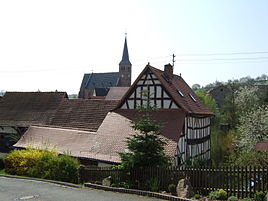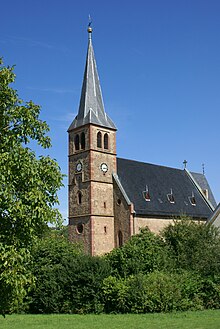Gunzenbach
|
Gunzenbach
Mömbris market
Coordinates: 50 ° 3 '32 " N , 9 ° 7' 47" E
|
|
|---|---|
| Height : | 257 m above sea level NN |
| Area : | 1.52 km² |
| Residents : | 567 (December 31, 2018) |
| Population density : | 373 inhabitants / km² |
| Incorporation : | 1818 |
|
Gunzenbach
|
|
Gunzenbach is part of municipality of market Mömbris in Aschaffenburg , Bavaria .
geography
Gunzenbach (in the local dialect: Gunzemich) is located in the Hutzelgrund in the Vor spessart , at an altitude of 257 m above sea level. NN between Rappach and Hohl . To the north of Gunzenbach are the villages of Molkenberg and Angelsberg and to the south-east of Rothengrund . The church village has 590 inhabitants and an area of 151.62 hectares. To the west of Gunzenbach is the mountain Scharfenstein and to the east the Steinberg . The Degen-Weg ran through the village until 2011 .
Surname
Gunzenbach takes its name from the Gunzenbach stream , which flows into the Hohlenbach near Rothengrund . The place is popularly called "Gunsemich".
history
middle Ages
The oldest surviving written mention of Gunzenbach can be found in a document from 1167. It is mentioned in it as part of the possessions of the Schlüchtern monastery . In the Middle Ages Gunzenbach belonged to the Mömbris court , which in turn was part of the Alzenau free court . The free court was directly imperial , but the empire pledged or lent the area again and again. So the rulers changed, including the lords and later counts of Hanau , the lords of Randenburg and the lords of Eppstein .
Modern times
In 1500 , the Roman-German King Maximilian I enfeoffed the Archbishop of Mainz and the Count of Hanau-Munzenberg together with the Freigericht, which they now administered as a condominium . Since ecclesiastical jurisdiction remained with the Archbishops of Mainz at the time of the condominium , the Reformation - in contrast to the County of Hanau-Münzenberg - could not prevail here. Gunzenbach remained Roman Catholic .
With Count Johann Reinhard III. the last male representative of the Hanau family died in 1736. The Landgrave of Hesse-Kassel was the heir of the Hanau-Münzenberg part of the state by virtue of a treaty . Whether his legacy also extended to Hanau's share in the condominium was heavily disputed in the following years between Kurmainz and Hessen-Kassel. The dispute ended in a compromise, the "party recession" of 1740, which provided for a real division of the condominium. However, it took until 1748 for the treaty to be implemented. Gunzenbach fell to Kurmainz.
Gunzenbach became part of the newly formed principality of Aschaffenburg of the Prince-Primate von Dalberg, with which it finally fell to Bavaria in 1814 (then a department of the Grand Duchy of Frankfurt).
On July 1, 1862, the Alzenau District Office was formed, on whose administrative area Gunzenbach was located. In 1939, as everywhere in the German Reich, the designation district was introduced. Gunzenbach was now part of the Alzenau district in Lower Franconia (license plate ALZ ). With the dissolution of the Alzenau district in 1972, Gunzenbach came into the newly formed Aschaffenburg district (license plate AB ).
Attractions
- The Catholic parish church of St. Michael was on 15 June 1896 the dean blessed the country chapter Alzenau, Father Johann Lorenz shaving members of Goldbach and only on 11 May 1909 by the Bishop of Wurzburg Ferdinand of Schlör consecrated . In the church, which was built in the neo-Gothic style, the appearance and furnishings of the time of construction have been preserved to this day.
- The local museum of the Mömbris market . It was created on the initiative of Emil Griebel , who was then the district homeschooler, in the old Gunzenbach school and has existed since May 14, 1977. The museum is open in summer on the 4th Sunday of the month from 2pm to 4pm.
- The school's show and teaching garden includes 20 plant areas with over 700 different plant species and varieties. The focus is on the wild fruits and rose collections.
education
- Gunzenbach elementary school (children in the 1st - 4th grade from the villages of Gunzenbach , Hohl , Rothengrund , Angelsberg , Molkenberg , Reichenbach and Daxberg are taught here).
- Jugendhaus Gunzenbach (The old rectory has been available as a self-catering house for children and youth groups since April 2009. The sponsor is the kja (church youth work) - regional office in Aschaffenburg. The house offers a practical and at the same time appealing setting for community experiences).
societies
- In Gunzenbach, in addition to the volunteer fire brigade, there is a Kolping family, a carrier pigeon club, a men's choir (since 2006 also with a women's choir), a music club, the Wolkenlos choir, a gymnastics club, a local VdK association, a Johanneszweig club, a football club and Gunzenbach motorcycle friends.
Web links
literature
- Emil Griebel: Chronicle of the Mömbris market with special consideration d. economic u. social Change in the 19th and 20th centuries 20th century with special consideration of the economic and social change in the 19th and 20th centuries . Mömbris 1982.
- Our bald ground . Homeland yearbook for the Alzenau district. Published by the working group for homeland research and homeland maintenance of the Alzenau district, district administrator. ISSN 0933-1328 .




